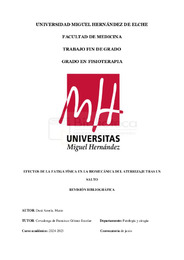Por favor, use este identificador para citar o enlazar este ítem:
https://hdl.handle.net/11000/37499Registro completo de metadatos
| Campo DC | Valor | Lengua/Idioma |
|---|---|---|
| dc.contributor.advisor | de Francisco Gómez Escolar, Covadonga | - |
| dc.contributor.author | Durá Azorín, Mario | - |
| dc.contributor.other | Departamentos de la UMH::Patología y Cirugía | es_ES |
| dc.date.accessioned | 2025-09-24T08:04:33Z | - |
| dc.date.available | 2025-09-24T08:04:33Z | - |
| dc.date.created | 2025-05-16 | - |
| dc.identifier.uri | https://hdl.handle.net/11000/37499 | - |
| dc.description.abstract | Introducción: Los saltos son un elemento clave en numerosos deportes y constituyen un gesto que requiere una elevada coordinación biomecánica. En etapas avanzadas de un entrenamiento, partido o temporada, cuando la fatiga puede comprometer el rendimiento, la estrategia del aterrizaje tras el salto puede verse alterada, lo que puede incrementar el riesgo de lesión. Objetivo: conocer si la fatiga genera alteraciones biomecánicas en la fase del aterrizaje tras un salto y cómo se presenta esta en diferentes variables. Material y métodos: se realizó una búsqueda en las bases de datos PubMed, Scopus y Embase. Fueron seleccionados estudios experimentales publicados entre 2014 y 2024 que analizaran la biomecánica del aterrizaje tras la inducción de fatiga física. Para valorar la calidad metodológica se utilizó la escala PEDro. Resultados: se obtuvieron 8 artículos en total. Las variables de resultados que se analizaron fueron los ángulos en el contacto inicial (IC), ángulos y momentos máximos para los diferentes movimientos de las articulaciones de la cadera, rodilla y tobillo, obteniéndose los principales resultados en los movimientos de flexión de rodilla y dorsiflexión, flexión plantar e inversión de tobillo. Conclusiones: existe evidencia de que la fatiga altera la biomecánica del aterrizaje, sin embargo, no lo hizo siguiendo el mismo patrón en todos los sujetos. Además, estas alteraciones provocadas fueron más susceptibles de lesionar el ligamento cruzado anterior, principalmente en aterrizajes monopodales. El tipo de fatiga provocada no mostró diferencias. | es_ES |
| dc.description.abstract | Introduction: Jumps are a key element in numerous sports and represent a movement that requires a high level of biomechanical coordination. In advanced stages of training, matches or the season, when fatigue may compromise performance, landing strategy after jumping can be altered, which may increase the risk of injury. Objective: To determine whether fatigue generates biomechanical alterations in the landing phase after a jump and how these manifest in different variables. Materials and Methods: A search was conducted in the PubMed, Scopus and Embase databases. Experimental studies pubished between 2014 and 2024 that analyzed the biomechanics of landing after the induction of physical fatigue were selected. The PEDro scale was used to asses methodological quality. Results: A total of 8 articles were obtained. The outcome variables analyzed were angles at initial contact (IC), as well as peak angles and moments for different join movements of the hip, knee and ankle, with the main findings related to knee flexion and ankle dorsiflexion, plantarflexion and inversion. Conclusions: There is evidence that fatigue alters landing biomechanics; however, it did not follow the same pattern in all subjects. Additionally, these alterations were more likely to put the anterior cruciate ligament at risk, especially during single-leg landings. The type of fatigue induced did not show significant differences. | es_ES |
| dc.format | application/pdf | es_ES |
| dc.format.extent | 44 | es_ES |
| dc.language.iso | spa | es_ES |
| dc.publisher | Universidad Miguel Hernández | es_ES |
| dc.rights | info:eu-repo/semantics/openAccess | es_ES |
| dc.rights | Attribution-NonCommercial-NoDerivatives 4.0 Internacional | * |
| dc.rights.uri | http://creativecommons.org/licenses/by-nc-nd/4.0/ | * |
| dc.subject | fatiga | es_ES |
| dc.subject | aterrizaje | es_ES |
| dc.subject | alteraciones | es_ES |
| dc.subject | biomecánica | es_ES |
| dc.subject | factores de riesgo | es_ES |
| dc.subject.other | CDU::6 - Ciencias aplicadas | es_ES |
| dc.title | Efectos de la fatiga física en la biomecánica del aterrizaje tras un salto. Revisión bibliográfica. | es_ES |
| dc.type | info:eu-repo/semantics/bachelorThesis | es_ES |

Ver/Abrir:
MARIO DURÁ AZORÍN - EFECTOS DE LA FATIGA FÍSICA EN LA BIOMECÁNICA DEL ATERRIZAJE TRAS UN SALTO.pdf
1,95 MB
Adobe PDF
Compartir:
 La licencia se describe como: Atribución-NonComercial-NoDerivada 4.0 Internacional.
La licencia se describe como: Atribución-NonComercial-NoDerivada 4.0 Internacional.
.png)